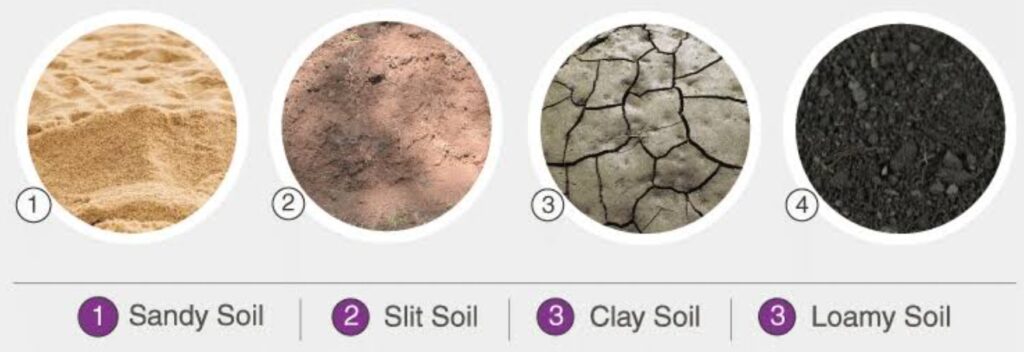DIFFERENCE BETWEEN SAND SILT AND CLAY
Introduction
- Sand silt and clay is grouped on the basis of their particle size. In fact, Soil texture is classified by the fraction of each soil separates i.e. sand, silt and clay.
- Sand particles are larger in size while clay particles are extremely fine, and silt particles are somewhere in between sand and clay particles.
- Sand, silt, and clay are the main mineral particles in the soil that affect its texture. Hence we can determine the soil texture through analyzing the mineral particles it contains.
- Soil texture influences soil physical and chemical properties like water holding capacity, nutrient retention, nutrient fixation, nutrient availability, drainage, strength, compressibility and thermal regime.
- These particles are made from weathering of rocks either through physical or chemical mode or biological weathering in some extent.

Sand
- Sand is a loose granular material consists of particles of rocks and minerals like silicon dioxide. So, it is most extensively used construction material.
- Sand particles are smaller than gravel but larger and coarser than silt. They are the largest and coarsest mineral particles in the soil. Each particle of sand is visible to the naked eye.
- Size of sand particle is larger than 0.05 mm in diameter. Furthermore, large sand particles can be described as coarse, medium, and the smaller as fine which all ranges from 0.05 to 2.00 mm in diameter.
- Sand particles can be angular, round, flat, or elongated while, the texture may be rough, smooth, or polished.
- The large, relatively stable sand-particle size increases soil aeration, improves drainage in tight soils and creates plant-growth supporting qualities, or tilt.
Silt
- Silt is a sediment material with an intermediate size between sand and clay, particle size of silt ranges from 0.002 and 0.05 mm. Silt typically has a mineral origin of quartz and feldspar.
- When dry, silt may feel similar to flour. When wet, it becomes smooth mud; when it’s very wet, can blend seamlessly with water and form very fine, runny puddles of mud.
- Because of fineness, silt has low plasticity or no plasticity at all.
Clay
- It is extremely fine-grained natural soil material containing clay minerals.
- Clay is the finest of all soil particles and is usually smaller than 0.002 mm. It consists of microscopic and sub-microscopic particles that come from the chemical decomposition of rocks.
- The fine grains of clay make the soil cohesive. Clay particles readily stick together and form a sticky texture when they are wet or dry.
- Due to more pore space, Clay soil can hold a good amount of water as compared to sand and silt.
- The more plastic a clay, the more workable it is, i.e., easier to mould into different shapes.
- Clay expands when in contact with water and shrinks when getting dry.
Difference between Sand Silt and Clay
Particulars | Sand | Silt | Clay |
Particles | Sand has coarse and larger particles. | Between the size of sand and clay particles. | Extremely fine particles. |
Size Range (Diameter) | 0.05-2.00 mm | 0.002-0.05 mm | <0.002 mm |
Plasticity | No plasticity. | Very low or no plasticity. | High plasticity. |
Name of soil separate Diameter limits (mm) Diameter limits (mm) Clay less than 0.002 less than 0.002 Silt 0.002 – 0.05 0.002 – 0.063 Very fine sand 0.05 – 0.10 0.063 – 0.125 Fine sand 0.10 – 0.25 0.125 – 0.20 Medium sand 0.25 – 0.50 0.20 – 0.63 Coarse sand 0.50 – 1.00 0.63 – 1.25 Very coarse sand 1.00 – 2.00 1.25 – 2.00
(USDA classification)
(WRB classification)
What is Loam?
- Loam is used to describe equal properties of sand, silt, and clay in a soil sample. A loam class contains 25-32% sand, 28-50% silt and 7-27% clay.
- Loamy soils are best for agricultural production because they retain more water and nutrients than sandy soil and have better drainage, aeration and tillage properties than clay soils.
- Depending on their predominant composition they can be either sandy or clay loam.
Read also…
SOIL CONSISTENCY- MEASURE AND ATTERBERG LIMIT
SOIL ORGANIC MATTER- MEANING & COMPONENT
SOIL WATER- CLASSES AND AVAILABILITY
Acidic, Saline and Alkaline Soil